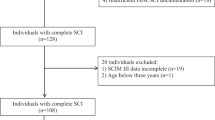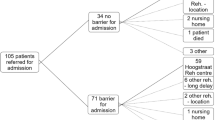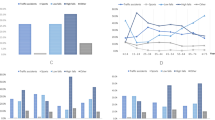Abstract
Design: Descriptive study.
Objective: To describe and compare the medical services provided following work-related tetraplegic spinal cord injury (SCI).
Setting: Workers’ compensation claims database.
Methods: The administrative database of a workers’ compensation provider was searched for work-related tetraplegia claims with dates of injury between 1 January 1989 and 31 December 1999. In total, 62 cases were identified and grouped by impairment category. Medical payment data were extracted and assigned to service categories.
Results: Although the level of services was directly related to the severity of impairment, patterns were similar across categories; for example, the largest proportions of payments were associated with durable medical equipment (DME) and attendant care in each impairment category. DME, readmissions and attendant care services varied considerably from year to year and within impairment category. Payments for physician care and medications/supplies showed the least variation within impairment categories. Workers’ compensation payments were similar to National Spinal Cord Injury Database (NSCID) payments for the first year following injury; however, in subsequent years, workers’ compensation figures were much higher.
Conclusions: Differences in annual medical payment and services by impairment category appear to be primarily due to variations in DME, attendant care and readmission. Payment differences in relation to National SCI figures may be related to better capture of payments by the workers’ compensation administrative database. In addition, results suggest broader coverage by workers’ compensation for medical services and items related to independent living.
Similar content being viewed by others
Log in or create a free account to read this content
Gain free access to this article, as well as selected content from this journal and more on nature.com
or
References
DeVivo M, Whiteneck G, Charles E . The economic impact of spinal cord injury. In: Stover SL De Lisa JA, Whiteneck GG (eds). Spinal Cord Injury: Clinical Outcomes from the Model Systems. Aspen Publishers: Gaithersburg, MD, 1995, pp 234–271.
Harvey C, Wilson SE, Greene CG, Berkowitz M, Stripling TE . New estimates of the direct costs of traumatic spinal cord injuries: results of a nationwide survey. Paraplegia 1992; 30: 834–850.
Berkowitz M, Harvey C, Greene CG, Wilson SE . The Economic Consequences of Traumatic Spinal Cord Injury. Demos Publications: New York, 1992.
Berkowitz M, O’Leary PK, Kruse DL, Harvey C . Direct costs of spinal injury. In: Berkowitz M (ed). Spinal Cord Injury: An Analysis of Medical and Social Costs. Demos Medical Publishing: New York 1998, pp 38–72.
Webster B, Giunti G, Young A, Pransky G, Nesathurai S . Work-related tetraplegia: causes of injury and annual medical costs. Spinal Cord 2004.
U.S. Department of Labor Consumer Price Index–All Urban Consumers, U.S. City Average, Medical Care, Series ID: CUUR0000SAM: Bureau of Labor Statistics.
Johnson RL, Brooks CA, Whiteneck GG . Cost of traumatic spinal cord injury in a population-based registry. Spinal Cord 1996; 34: 470–480.
DeVivo MJ, Rutt RD, Black KJ, Go BK, Stover SL . Trends in spinal cord injury demographics and treatment outcomes between 1973 and 1986. Arch Phys Med Rehabil 1992; 73: 424–430.
Fiedler I, Laud P, Maiman D, Apple D . Economics of managed care in spinal cord injury. Arch Phys Med Rehabil 1999; 80: 1441–1449.
Eastwood E, Hagglund K, Ragnarsson K, Gordon W, Marino R . Medical rehabilitation length of stay and outcomes for persons with traumatic spinal cord injury – 1990–1997. Arch Phys Med Rehabil 1999; 80: 1457–1463.
Cifu D, Seel R, Kreutzer J, McKinley W . A multicenter investigation of age-related differences in lengths of stay, hospitalization charges, and outcomes for a matched tetraplegia sample. Arch Phys Med Rehabil 1999; 80: 733–740.
Price C, Makintubee S, Herndon W, Istre G . Epidemiology of traumatic spinal cord injury and acute hospitalization and rehabilitation charges for spinal cord injuries in Oklahoma, 1988–1990. Am J Epidemiol 1994; 139: 37–47.
Tate DG, Stiers W, Daugherty J, Forchheimer M, Cohen E, Hanson N . The effects of insurance benefits coverage on functional and psychosocial outcomes after spinal cord injury. Arch Phys Med Rehabil 1994; 75: 407–414.
Krause JS, Anson CA . Employment after spinal cord injury: relation to selected participant characteristics. Arch Phys Med Rehabil 1996; 77: 737–743.
Young ME, Alfred WG, Rintala DH, Hart KA, Fuhrer MJ . Vocational status of persons with spinal cord injury living in the community. Rehabil Counsel Bull 1994; 37: 229–243.
Krause S, Sternberg M, Naidesm J, Lottes S . Employment after spinal cord injury: differences related to geographic region, gender and race. Arch Phys Med Rehabil 1998; 79: 615–624.
Levi R, Hultling C, Seiger A . The Stockholm spinal cord injury study: 4. psychological and financial issues of the Swedish annual level-of-living survey in SCI subjects and controls. Paraplegia 1996; 34: 152–157.
Young A, Murphy G . A social psychology approach to measuring vocational rehabilitation intervention effectiveness. J Occup Rehabil 2002; 12: 175–189.
McShane SL, Karp J . Employment following spinal cord injury: a covariance structure analysis. Rehabil Psychol 1993; 38: 27–40.
Levi R . The Stockholm Spinal Cord Injury Study: Medical, Economical and Psycho-social Outcomes in a Prevalence Population. Karolinska Institute: Stockholm, 1996.
Krause JS . Employment after spinal cord injury: transition and life adjustment. Rehabil Counsel Bull 1996; 39: 244–255.
Krause JS, Anson CA . Adjustment after spinal cord injury: relationship to participation in employment and educational activities. Rehabil Counsel Bull 1997; 40: 202–214.
Athelstan GT . Vocational assessment and management. In: Kottke FJ, Lehmann JF (eds). Krusen's Handbook of Physical Medicine and Rehabilitation. WB Saunders: Philadelphia, PA, 1990, pp 181–205.
Yeo JD, Walsh J, Rutkowski S, Soden R, Craven M, Middleton J . Mortality following spinal cord injury. Spinal Cord 1998; 36: 329–336.
Acknowledgements
This research was supported, in part, by a grant from the National Institute on Disability and Rehabilitation Research National Model SCI Systems (Grant # H133N00024). We acknowledge Jamil Ahmed, Radha Vijaykumar, Ashar Ata, Russel Hensel and Santosh Verma for their assistance.
Author information
Authors and Affiliations
Rights and permissions
About this article
Cite this article
Young, A., Webster, B., Giunti, G. et al. Services provided following compensable work-related tetraplegia. Spinal Cord 42, 248–260 (2004). https://doi.org/10.1038/sj.sc.3101598
Published:
Issue date:
DOI: https://doi.org/10.1038/sj.sc.3101598



